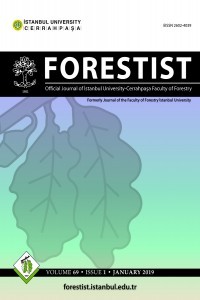UZAKTAN ALGILAMA VERİLERİNDE SINIFLANDIRMA DOĞRULUĞUNUN BELİRLENMESİ YÖNTEMLERİ
1970'li yıllardan günümüze, geliştirilmiş çok sayıda algılayıcı verisi, geniş alanlara yönelik bilgi toplama ve çeşitli konusal haritaların üretilmesinde yaygın bir şekilde kullanılmaktadır. Uzaktan algılanmış görüntülerden elde edilen veri ve haritaların kullanıcıları, doğal olarak kullanacakları bilginin doğruluğunu sorgular. Ancak, doğruluk ile ilgili soruları, ikna edici bir tarzda yanıtlamak oldukça güçtür. Bu makalede, uzaktan algılama verilerinden elde edilmiş bir harita veya sınıflandırılmış bir görüntünün doğruluğunun farklı doğruluk değerlendirme yöntemlerine göre nasıl belirlendiği, bir örnek üzerinde uygulamalı olarak anlatılmıştır.
Anahtar Kelimeler:
Uzaktan Algılama, Doğruluk Belirleme, Hata Matrisi, Üretici Doğruluğu, Kullanıcı Doğruluğu, İhmal Hatası, Görev Hatası
___
- ARONOFF, S. 1982: Classification Accuracy : A User Approach. Photogrammetric Engineering and Remote Sensing, Vo1.48, No.8, August 1982, pp.1299-1307.
- ASPRS, i997: Manuel of Photographic Interpretation. ASPRS (American Society for Photogrammetry and Remote Sensing), Second Edition, ISBN 1-57083-039-8.689 sayfa.
- CAMPBELL, J.B. 1996: Introduction to Remote Sensing. Second Edition. Virginia Polytechnic Institute and State University, The Guildford Pres, New York-London.
- CARD, D.H. 1982: Using known map category marginal frequencies to improve estimates of thematic map accuraey. Photogrammetric Engineering & Remote Sensing 48(3): pp. 431-439.
- CONGALTON. R.ç:;. 1991: A review of assessing the accuracy of classifications of remotely sensed data. Remote Sensing of Environment 37( i): pp. 35-46.
- CONGALTON, R. G.; GREEN. K. 1993: A practical look at the sources of confusion in error matrix generation. Photogrammetric Engineering and Remote Sensing, 59, 641- 644.
- CONGAL TON. R.G. 1994 : Accuracy assessment of remotely sensed data: future needs and directions. In: Proceedings of Pecora 12 land information from space-based systems ( pp. 383- 388). Bethesda: ASPRS.
- FOOOY. G.M. 2002: Status of land cover Cıassification accuracy assessment. Remote Sensing of Environrnent. 80 (2002) 185- 20 i
- HA Y, A.M. 1979 : Sampling Designs to Test Land Use Map Accuracy. Photogrammetric Engineering and Remote Sensing, Vo1.45, No.4, April 1979, pp.529-533.
- HORD.R.M.; BROONER, W. 1976: Land Use Map Accuracy Criteria. Photogrammetric Engineering and Remote Sensing, Vo1.46, pp.671-677.
- JANSSEN, L.L.F.;VAN DER WEL, FJ.M. 1994: Accuracy assessment of sarellite derived landcover data: a review. Photogrammetric Engineering and Remote Sensing, 60,4 i9- 426.
- JENSEN, J. R. 1996: Introductory digital image processing. A remote sensing perspective.Second Edition, New Jersey: Prentice-Hall.
- LILLESAND, T.M.; KIEFER, R.W .. 1994 : Remote Sensing and Image Interpretation. Third Edition. ISBN 0-471-57783-9, Printed and bound by Rfc.Donnelleyrf.rawfordsville), The cover was printed by Lehigh Pres, Printed in the USA.
- MATHER. P.M. 1993: Computer Processing of Rernotely-Sensed lmages. Third Edition. ISBN O 47 i 906484. Printed and bound in Great Britain by Biddles Ltd. Guildford and King's Lynn.
- RICHARDS, J.A.; JIA, X. 1999 : Remote Sensing Digital Image Analysis. Third. Revised and Enlarged Edition, ISBN 3-540-64860-7, Springer-Verlag Berlin Heidelberg New York.
- SMITS, P. C.; DELLEPIANE. S. G.; SCHOWENGERDT, R. A. 1999: Quality assessment of image classification a1gorithms for land-cover mapping: a reviewand proposal for a cost-based approach. International Journal of Remote Sensing, 20, 1461-1486.
- STORY, M.; CONGALTON, R.G. 1986: Accuracy assessment: a user's perspective. Photogrammetric Engineering and Remote Sensing, 52, 397- 399.
- Başlangıç: 1951
- Yayıncı: İstanbul Üniversitesi-Cerrahpaşa
Sayıdaki Diğer Makaleler
İlker AKYÜZ, Kemal ÜÇÜNCÜ, Kadri Cemil AKYÜZ
EMPRENYE MADDELERİNİN PİKNİK MASALARI VE ÇOCUK OYUN ALANI ELEMANLARINDA KULLANIMI
S. Nami KARTAL, Ramazan KANTAY
İki değerli silvikültür profesörünün ardından
Bülend Seçkin, Ş. Doğanay Yayım
KİMYASAL MADDE KULLANAN İŞLETMELERDE ÖRGÜTSEL KONTROL ÖNLEMLERİ
ÇİMLENME ENGELİNİN GİDERİLMESİNDE NEM DENETİMLİ ÇIPLAK KATLAMA YÖNTEMİ
İstanbul üniversitesi orman fakültesinin ikinci kuşak öğretim üyeleri (1960-1980)
Abdi Ekizoğlu, H. Tezcan Yıldırım
UYDU VERİLERİNDE TOPOGRAFİK ETKİNİN GİDERİLMESİ YÖNTEMLERİ
Ayhan Koç, Hakan Yener, H. Oğuz Çoban
TÜRKİYE'DE ODUN ÜRETİMİNİN İŞ AŞAMALARI
PEYZAJ MİMARLIĞINDA KİŞİSEL MEKAN KAVRAMI VE KİŞİSEL MEKAN ÖLÇME TEKNİKLERİNİN DEĞERLENDİRİLMESİ
